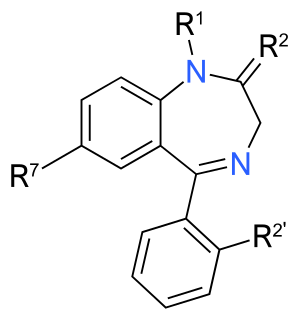Related Research Articles

Alcoholism is, broadly, any drinking of alcohol that results in significant mental or physical health problems. Because there is disagreement on the definition of the word alcoholism, it is not a recognized diagnostic entity. Predominant diagnostic classifications are alcohol use disorder (DSM-5) or alcohol dependence (ICD-11); these are defined in their respective sources.

Benzodiazepines, sometimes called "benzos", are a class of psychoactive drugs whose core chemical structure is the fusion of a benzene ring and a diazepine ring. As depressants—drugs which lower brain activity—they are prescribed to treat conditions such as anxiety, insomnia, and seizures. The first benzodiazepine, chlordiazepoxide (Librium), was discovered accidentally by Leo Sternbach in 1955 and was made available in 1960 by Hoffmann–La Roche, which soon followed with diazepam (Valium) in 1963. By 1977, benzodiazepines were the most prescribed medications globally; the introduction of selective serotonin reuptake inhibitors (SSRIs), among other factors, decreased rates of prescription, but they remain frequently used worldwide.

Substance abuse, also known as drug abuse, is the use of a drug in amounts or by methods which are harmful to the individual or others. It is a form of substance-related disorder. Differing definitions of drug abuse are used in public health, medical and criminal justice contexts. In some cases, criminal or anti-social behaviour occurs when the person is under the influence of a drug, and long-term personality changes in individuals may also occur. In addition to possible physical, social, and psychological harm, the use of some drugs may also lead to criminal penalties, although these vary widely depending on the local jurisdiction.

Alcohol dependence is a previous psychiatric diagnosis in which an individual is physically or psychologically dependent upon alcohol.
Physical dependence is a physical condition caused by chronic use of a tolerance-forming drug, in which abrupt or gradual drug withdrawal causes unpleasant physical symptoms. Physical dependence can develop from low-dose therapeutic use of certain medications such as benzodiazepines, opioids, antiepileptics and antidepressants, as well as the recreational misuse of drugs such as alcohol, opioids and benzodiazepines. The higher the dose used, the greater the duration of use, and the earlier age use began are predictive of worsened physical dependence and thus more severe withdrawal syndromes. Acute withdrawal syndromes can last days, weeks or months. Protracted withdrawal syndrome, also known as post-acute-withdrawal syndrome or "PAWS", is a low-grade continuation of some of the symptoms of acute withdrawal, typically in a remitting-relapsing pattern, often resulting in relapse and prolonged disability of a degree to preclude the possibility of lawful employment. Protracted withdrawal syndrome can last for months, years, or depending on individual factors, indefinitely. Protracted withdrawal syndrome is noted to be most often caused by benzodiazepines. To dispel the popular misassociation with addiction, physical dependence to medications is sometimes compared to dependence on insulin by persons with diabetes.
Substance dependence, also known as drug dependence, is a biopsychological situation where-by an individual's functionality is dependent on the necessitated re-consumption of a psychoactive substance, because of an adaptive state that has developed within the individual from psychoactive substance consumption, which results in the experience of withdrawal, which necessitates the re-consumption of the drug. A drug addiction, a distinct concept from substance dependence, is defined as compulsive, out-of-control drug use, despite negative consequences. An addictive drug is a drug which is both rewarding and reinforcing. ΔFosB, a gene transcription factor, is now known to be a critical component and common factor in the development of virtually all forms of behavioral and drug addictions, but not dependence.

The Alcohol Use Disorders Identification Test (AUDIT) is a ten-item questionnaire approved by the World Health Organization to screen patients for hazardous (risky) and harmful alcohol consumption. It was developed from a WHO multi-country collaborative study, the items being selected for the AUDIT being the best performing of approximately 150 items including in the original survey. It is widely used as a summary measure of alcohol use and related problems. It has application in primary health care, medical clinics, and hospital units and performs well in these settings. Using different cut-off points, it can also screen for Alcohol Use Disorder (DSM-5) and Alcohol Dependence. Guidelines for the use of the AUDIT have been published by WHO and are available in several languages. It has become a widely used instrument and has been translated into approximately fifty languages.

The CAGE questionnaire, the name of which is an acronym of its four questions, is a widely used screening test for problem drinking and potential alcohol problems. The questionnaire takes less than one minute to administer, and is often used in primary care or other general settings as a quick screening tool rather than as an in-depth interview for those who have alcoholism. The CAGE questionnaire does not have a specific intended population, and is meant to find those who drink excessively and need treatment. The CAGE questionnaire is reliable and valid; however, it is not valid for diagnosis of other substance use disorders, although somewhat modified versions of the CAGE questionnaire have been frequently implemented for such a purpose.

Alcohol detoxification is the abrupt cessation of alcohol intake in individuals that suffer from alcohol dependence. This process is often coupled with substitution of drugs that have effects similar to the effects of alcohol in order to prevent alcohol withdrawal. When withdrawal does occur, it results in symptoms of varying severity.

Alcohol withdrawal syndrome (AWS) is a set of symptoms that can occur following a reduction in alcohol use after a period of excessive use. Symptoms typically include anxiety, shakiness, sweating, vomiting, fast heart rate, and a mild fever. More severe symptoms may include seizures, hallucinations, and delirium tremens (DTs). Symptoms typically begin around six hours following the last drink, are worst at 24 to 72 hours, and improve by seven days.

Benzodiazepine dependence defines a situation in which one has developed one or more of either tolerance, withdrawal symptoms, drug seeking behaviors, such as continued use despite harmful effects, and maladaptive pattern of substance use, according to the DSM-IV. In the case of benzodiazepine dependence, however, the continued use seems to be associated with the avoidance of unpleasant withdrawal reaction rather than from the pleasurable effects of the drug. Benzodiazepine dependence develops with long-term use, even at low therapeutic doses, without the described dependence behavior.

Benzodiazepine use disorder (BUD), also called misuse or abuse, is the use of benzodiazepines without a prescription, often for recreational purposes, which poses risks of dependence, withdrawal and other long-term effects. Benzodiazepines are one of the more common prescription drugs used recreationally. When used recreationally benzodiazepines are usually administered orally but sometimes they are taken intranasally or intravenously. Recreational use produces effects similar to alcohol intoxication.

The CRAFFT is a short clinical assessment tool designed to screen for substance-related risks and problems in adolescents. CRAFFT stands for the key words of the 6 items in the second section of the assessment - Car, Relax, Alone, Forget, Friends, Trouble. As of 2020, updated versions of the CRAFFT known as the “CRAFFT 2.1” and "CRAFFT 2.1+N" have been released.

Substance use disorder (SUD) is the persistent use of drugs despite substantial harm and adverse consequences. Substance use disorders are characterized by an array of mental/emotional, physical, and behavioral problems such as chronic guilt; an inability to reduce or stop consuming the substance(s) despite repeated attempts; driving while intoxicated; and physiological withdrawal symptoms. Drug classes that are involved in SUD include: alcohol; cannabis; phencyclidine and other hallucinogens, such as arylcyclohexylamines; inhalants; opioids; sedatives, hypnotics, or anxiolytics; stimulants; tobacco; and other or unknown substances.

Cannabis use disorder (CUD), also known as cannabis addiction or marijuana addiction, is defined in the fifth revision of the Diagnostic and Statistical Manual of Mental Disorders (DSM-5) and ICD-10 as the continued use of cannabis despite clinically significant impairment.
The Patient Health Questionnaire (PHQ) is a multiple-choice self-report inventory that is used as a screening and diagnostic tool for mental health disorders of depression, anxiety, alcohol, eating, and somatoform disorders. It is the self-report version of the Primary Care Evaluation of Mental Disorders (PRIME-MD), a diagnostic tool developed in the mid-1990s by Pfizer Inc. The length of the original assessment limited its feasibility; consequently, a shorter version, consisting of 11 multi-part questions - the Patient Health Questionnaire was developed and validated.
The Clinical Institute Withdrawal Assessment for Alcohol, commonly abbreviated as CIWA or CIWA-Ar, is a 10-item scale used in the assessment and management of alcohol withdrawal. Each item on the scale is scored independently, and the summation of the scores yields an aggregate value that correlates to the severity of alcohol withdrawal, with ranges of scores designed to prompt specific management decisions such as the administration of benzodiazepines. The maximum score is 67; Mild alcohol withdrawal is defined with a score less than or equal to 10, moderate with scores 11 to 15, and severe with any score equal to or greater than 16.

The Mood Disorder Questionnaire (MDQ) is a self-report questionnaire designed to help detect bipolar disorder. It focuses on symptoms of hypomania and mania, which are the mood states that separate bipolar disorders from other types of depression and mood disorder. It has 5 main questions, and the first question has 13 parts, for a total of 17 questions. The MDQ was originally tested with adults, but it also has been studied in adolescents ages 11 years and above. It takes approximately 5–10 minutes to complete. In 2006, a parent-report version was created to allow for assessment of bipolar symptoms in children or adolescents from a caregiver perspective, with the research looking at youths as young as 5 years old. The MDQ has become one of the most widely studied and used questionnaires for bipolar disorder, and it has been translated into more than a dozen languages.
The 9-question Patient Health Questionnaire (PHQ-9) is a diagnostic tool introduced in 2001 to screen adult patients in a primary care setting for the presence and severity of depression. It rates depression based on the self-administered Patient Health Questionnaire (PHQ). The PHQ is part of Pfizer's larger suite of trademarked products, called the Primary Care Evaluation of Mental Disorders (PRIME-MD). The PHQ-9 takes less than 3 minutes to complete and simply scores each of the 9 DSM-IV criteria for depression based on the mood module from the original PRIME-MD. Primary care providers frequently use the PHQ-9 to screen for depression in patients.

Prescription drug addiction is the chronic, repeated use of prescription drug in ways other than prescribed for, including using someone else’s prescription. A prescription drug is a pharmaceutical drug that must be dispensed with a legal medical prescription. Drugs in this category are supervised due to their potential for misuse and Substance use disorder. The classes of medications most commonly abused are opioids, central nervous system (CNS) depressants and central nervous stimulants. In particular, prescription opioid is most commonly abused in the form of prescription analgesics.
References
- ↑ Stockwell T, Murphy D, Hodgson R (1983). "The severity of alcohol dependence questionnaire: Its use, reliability and validity". British Journal of Addiction. 78 (2): 45–156. doi:10.1111/j.1360-0443.1983.tb05502.x. PMID 6135435.
- ↑ Raistrick, D, Heather N, Godfrey C (2006). "Review of the Effectiveness of Treatment for Alcohol Problems" (PDF). London: National Treatment Agency for Substance Misuse. Archived from the original (PDF) on 2009-03-18. Retrieved 2009-03-26.
- ↑ "Severity of Alcohol Dependence Questionnaire (SADQ) sample" (PDF). NIAAA. Archived from the original (PDF) on August 18, 2006. Retrieved August 2, 2016.
- ↑ http://www.harrogatehealth.nhs.uk/gpguidelinesupload/GP%20Guidelines/Prescribing%20guidelines%20for%20alcohol%20misuse%20disorders%20Executive%20summary.doc%5B%5D